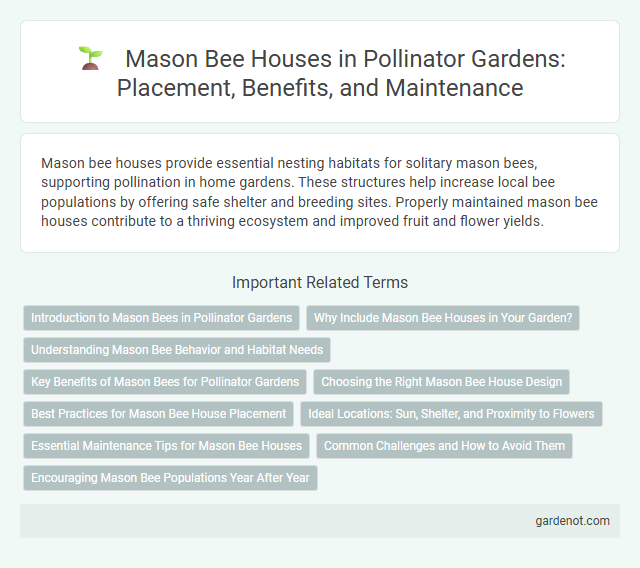Mason bee houses provide essential nesting habitats for solitary mason bees, supporting pollination in home gardens. These structures help increase local bee populations by offering safe shelter and breeding sites. Properly maintained mason bee houses contribute to a thriving ecosystem and improved fruit and flower yields.
Introduction to Mason Bees in Pollinator Gardens
Mason bees (genus Osmia) are solitary pollinators known for their efficiency in fruit and vegetable crop pollination, making them valuable additions to pollinator gardens. These bees use natural cavities or artificial bee houses filled with tubes or tunnels to nest, where females independently provision each cell with pollen and nectar before sealing it with mud. Incorporating a mason bee house enhances local biodiversity and supports ecosystem services by increasing pollination rates, especially in early spring when many mason bee species emerge.
Why Include Mason Bee Houses in Your Garden?
Mason bee houses provide essential shelter for solitary mason bees, which are highly efficient pollinators that increase fruit and vegetable yields by up to 30%. These structures encourage native bee populations, supporting biodiversity and enhancing garden health without the need for harmful pesticides. Installing mason bee houses boosts pollination during critical flowering periods, ensuring robust plant growth and ecological balance.
Understanding Mason Bee Behavior and Habitat Needs
Mason bees prefer solitary nesting sites composed of hollow tubes or cavities, making bee houses with narrow tunnels ideal for their reproduction. These bees thrive in habitats rich in native flowering plants that supply abundant pollen and nectar throughout spring and early summer. Providing suitable shelter that mimics natural conditions, such as protection from rain and predators, supports successful nesting and population growth of mason bees.
Key Benefits of Mason Bees for Pollinator Gardens
Mason bees significantly enhance pollinator gardens by increasing pollination efficiency, resulting in higher fruit and flower yields. Their non-aggressive nature makes them safe for garden environments, while their solitary nesting habits reduce the risk of disease transmission. Utilizing mason bee houses supports local ecosystems by providing essential habitats, boosting biodiversity and promoting sustainable gardening practices.
Choosing the Right Mason Bee House Design
Selecting the right Mason bee house design involves prioritizing materials like untreated wood or recycled natural fibers that provide a safe, chemical-free environment for nesting. Optimal dimensions include tunnel diameters between 5 to 8 millimeters and depths of 6 to 8 centimeters to accommodate the species' nesting preferences. Proper placement of the house in a sunny, sheltered spot facing southeast enhances bee activity and pollination efficiency in pollinator gardens.
Best Practices for Mason Bee House Placement
Place mason bee houses in a sunny spot facing southeast to maximize morning warmth, which encourages early bee activity and efficient pollination. Mount the house 3 to 5 feet above ground to protect from ground moisture and predators, ensuring stability by securing it firmly to a post or tree. Avoid placing the house near windy or damp areas to maintain dry nesting tubes, improving the bees' survival and reproduction rates.
Ideal Locations: Sun, Shelter, and Proximity to Flowers
Mason bee houses thrive in sunny locations that receive at least six hours of direct sunlight daily, promoting bee activity and warmth. Sheltered spots protected from strong winds and heavy rain ensure the safety and longevity of the nesting tubes. Positioning the house close to diverse, pesticide-free flowering plants within 300 feet maximizes foraging efficiency and supports healthy pollination.
Essential Maintenance Tips for Mason Bee Houses
Regular cleaning of mason bee houses prevents disease buildup and promotes healthy colonies. Replace nesting tubes annually to avoid mold and parasites that can harm bees. Position houses in sunny, sheltered locations with good airflow to support optimal bee activity and reproduction.
Common Challenges and How to Avoid Them
Common challenges with Mason bee houses include moisture buildup, predation by birds or wasps, and improper placement. To avoid these issues, ensure the bee house is mounted in a sunny, sheltered location with good ventilation and use materials that repel pests. Regularly clean and replace nesting tubes to maintain a healthy environment for Mason bees.
Encouraging Mason Bee Populations Year After Year
A well-designed mason bee house provides safe nesting cavities that encourage prolific reproduction and support growing mason bee populations year after year. Selecting durable, weather-resistant materials and regularly cleaning the house prevents disease and ensures optimal conditions for the bees' lifecycle. Positioning the house in a sunny, sheltered spot near diverse flowering plants enhances pollination and fosters a thriving pollinator garden ecosystem.
Mason bee house Infographic

 gardenot.com
gardenot.com